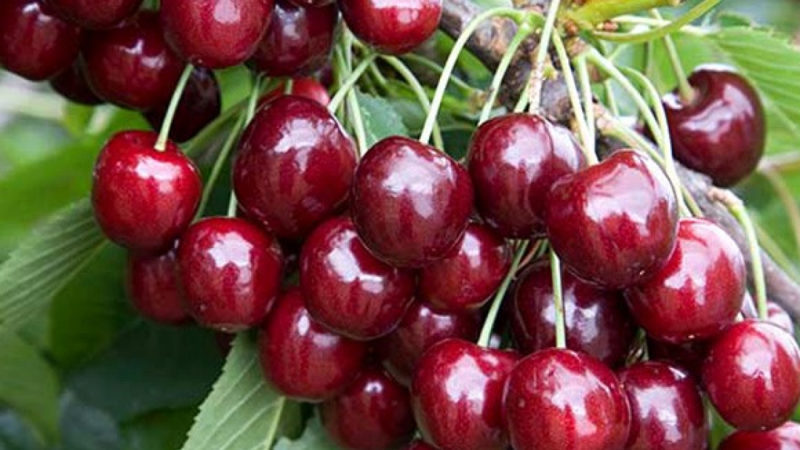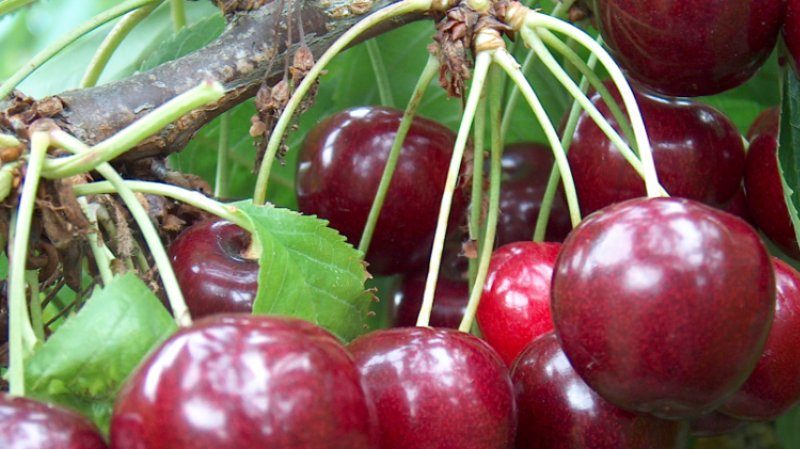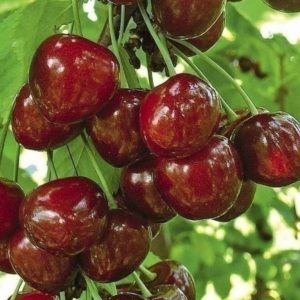Yielding and disease-resistant cherry variety "Regina"
Regina is a promising sweet cherry, one of the best varieties of late ripening. It is resistant to many diseases, begins to bear fruit early, gives a bountiful harvest and is suitable for growing both on private plots and on an industrial scale. In this article, we will tell you in detail about the features of the variety and the rules of agricultural technology when growing it.
The content of the article
What is this variety of cherry

Regina is a late-ripening cherry variety characterized by annual flowering and fruiting.
Trees begin to bear fruit 3-4 years after planting. The yield in the first year is low (up to 5 kg), but it increases every year, and up to 40 kg of berries are harvested from an adult tree.
Ripe fruits can remain on the tree for 10-12 days, in the refrigerator they are stored without loss of quality for more than 2 weeks.
Brief history of origin and distribution
Regina was bred in 1957 by German breeders based on the varieties Rube and Schneider. The planting material went on sale only in 1981.
The variety spread to European and post-Soviet countries after the end of the 25-year ban on the export of seedlings.
Characteristics and description of the variety
The tree is medium-sized with a neat, medium-thickened pyramidal crown. Shoots are located at an angle of almost 90 ° to a pronounced central conductor, covered with gray-brown bark.
The leaves are green, elliptical in shape with pointed ends and serrated edges. The outer surface of the leaf plates is leathery and glossy, the inner surface is matte and lighter.
Flowering depends on climatic conditions and begins when the air temperature reaches + 15 ° C. Most often this is mid or late May. The flowers are large, five-petal, white, collected in inflorescences of 2-3 pcs.
Reference. Trees grow about 50 cm annually and reach a height of 3-4 m in adulthood.
Resistant to temperatures
This is a variety with an average degree of frost resistance: trees can withstand a drop in air temperature down to -25 ° C, but they do not take root in regions with more severe winters.
Moisture and drought resistance
Drought resistance is average - drying out of the soil at the roots is unacceptable, otherwise the yield decreases. With prolonged waterlogging of the soil, the quality of the fruits deteriorates.
Disease and pest resistance
Regina has good immunity to fungal diseases and pests. But under unfavorable conditions, the plant is affected by moniliosis, gum flow, mosaic disease, black aphid, cherry tube worm and gypsy moth.
Characteristics and description of berries

The berries are round-heart-shaped, reach 3.2 cm in diameter and weigh an average of 9-10 g, are covered with a dense, glossy, smooth skin of dark red color.
The pulp is slightly lighter than the skin, gristly, dense and juicy, has a rich sweet taste with a slight acidity. The stone is medium, well separated.
Areas of their application
Regina berries are consumed fresh, frozen, used for making desserts, compotes, jams, pastilles, juices, wine and tinctures.
Advantages and disadvantages of the variety
The main advantages of Regina:
- early maturity;
- consistently high yield;
- great taste of berries;
- high immunity to diseases and pests;
- late flowering, which eliminates the likelihood of shedding flowers in case of recurrent frosts;
- late ripening;
- good commercial quality of berries;
- transportability and good keeping quality;
- the possibility of universal application;
- the ability of berries to remain on trees after ripening, without crumbling or cracking.
Cons of the variety:
- self-infertility;
- poor resistance to frost and drought.

Growing technology
For trees to take root, grow and bear fruit, it is necessary to observe the rules and dates for planting seedlings and provide them with proper care.
Optimal conditions
Regina develops well and bears fruit on nutritious, loose soil with good aeration, moisture permeability and medium acidity (pH 5.5). The best option is loamy and sandy loam soil.
For planting, choose 1- or 2-year-old seedlings with a stem 1-1.5 m high, 3-5 skeletal branches 35 cm long, an aligned trunk, a well-developed root system and 3-4 main shoots.
Reference. On the trunk, 5 cm from the rhizome, there should be a slight bend with a healed cut of the rootstock.
Before planting, the roots of the seedlings are soaked for 2-3 hours in a solution of growth stimulants ("Kornevin", "Heteroauxin").
Terms and rules of landing
Trees are planted in a well-lit and protected from the north wind in a place located in the south, southeast or southwest of the site. The depth of the groundwater is at least 2 m.
Planting is carried out in spring (mid-April - May), when there is no risk of return frosts, or in autumn (late September - early October).
In the first case, the plants increase their resistance to frost, it is possible to monitor the phases of the growing season and the degree of adaptation of seedlings, but the choice of planting material is limited, and the plantings need laborious care.
Autumn planting is permissible when growing Regina in the areas with a warm and mild climate. At this time, there is a rich selection of seedlings, and newly planted trees require minimal maintenance. The inability to control weather conditions increases the risk of tree death.
The site is prepared 6 months before planting - the soil is dug up to a depth of at least 30 cm and watered with a 3% solution of copper sulfate for disinfection. 7-10 days after that, for every 1 sq. m make:
- loam and sandy loam - 20 kg of fresh manure and 400 g of superphosphate;
- acidic soil - 20 kg of compost, 20 kg of sand and 400 g of dolomite flour;
- heavy soil - 20 kg of manure and 400 g of superphosphate, 10 kg of peat and sand.
After fertilization, the soil is re-dug to a depth of 30 cm.
Landing rules:
- A week before planting, prepare rows on the site at a distance of 3-4 m from each other.
- Every 3 m, dig planting holes in them 70 cm deep and 1 m wide.
- Fill each pit by a third with a nutrient mixture: the top 30-40 cm of excavated soil, 20 kg of compost or humus, 10 kg of sand, 100 g of potassium sulfate and 1 kg of wood ash.
- Drive a stake into the center of the pit so that it rises 0.5 m above the surface.
- Fill the pits with water at the rate of 20 liters each.
- Form a cone-shaped hill in the center of the planting pit, install a seedling on it, spreading its roots over the pit area.
- Cover the seedling with soil mixture, distributing it between the roots.
- Align the inoculation site so that it is 5 cm above the ground.
- Fill the hole with soil, compact it in the trunk circle.
- Pour 20 liters of water over the seedling and cover the soil with compost.
- Tie the seedling to the stake with a natural soft cloth.
The best neighbors for cherries are cherry, honeysuckle, plum. The crop is not planted next to pear, linden, birch, conifers, nightshade crops, tobacco, eggplant, pepper and seed trees, especially apple trees.
Read also:
Further care

Within 3 years after planting, the trees are watered 2 times a month, pouring 30 liters of water under each. Adult fruit-bearing trees are watered monthly if the weather is dry, or 3 times per season: during the swelling of the buds, 2 weeks after flowering, and 3 weeks before the fruit is fully ripe. Water consumption - 60 liters under a tree at a time.
Reference. In the case of dry autumn, watering is required in mid-October, otherwise the tree will not overwinter.
After watering, the soil is loosened and weeded, and then the trunk circle is mulched with compost or fresh grass.
They begin to feed cherries a year after planting according to the scheme:
- every 2 years in mid-October - 40 kg of rotted manure;
- annually in the spring - 200 g of superphosphate and 100 g of potassium sulfate;
- during swelling of the kidneys - 150 g of urea or 75 g of nitrophoska;
- 14 days after flowering - wood ash.
Sanitary pruning is carried out annually in spring, removing broken, damaged shoots growing inward. A dense tiered-sparse crown shape is formed within 4-5 years so that the lower branches are 50-60 cm from the ground, the distance between the tiers is 50-60 cm, and each tier consisted of 3 branches.
Possible problems, diseases, pests
Diseases and pests that threaten Regina:
| Disease / pest | Description | Treatment |
|---|---|---|
| Moniliosis | Branches and leaves darken and dry out, unripe fruits are mummified, bark bursts on trees. | Trees and soil are sprayed twice with an interval of 10 days with the preparation "Horus" (2 g / 10 l of water) at the rate of 1 l per 10 sq. m. |
| Gum therapy | An amber, viscous, bitterish liquid - gum - is released from the cracks in the trunk. | The affected area is cleaned from gum to healthy tissues, the surface is disinfected with a solution of copper sulfate and sealed with garden varnish. |
| Mosaic disease | Clear yellow stripes appear on the leaves along the veins, the leaves curl, develop abnormally, after a while they turn red, turn brown and die prematurely. | There is no cure. The infected tree is uprooted and burned, nothing is planted in its place for 5 years. |
| Black aphid | The larvae suck the juice from young leaves, after a month they curl up and dry up, the buds wither. | Trees and soil are powdered with tobacco dust or wood ash. If this does not help, use the drug "Aktara". |
| Cherry pipe runner | The leaves curl up, twist into a tube, sometimes crumble, the hatched larvae eat them. | |
| Unpaired silkworm | Caterpillars strongly eat cherry leaves. |
Wintering
Preparation for winter consists in:
- removing old mulch,
- cleansing the trunk of damaged bark and whitewashing it with lime,
- shallow digging of soil,
- watering and covering the trunk circle with a new layer of mulch.
Young seedlings are wrapped in burlap and spruce branches to protect them from the cold and rodents.
Reproduction
The variety is propagated using cuttings. To do this, developed shoots are cut into pieces with 3-5 leaves no more than 30 cm long, dipped in a solution of a growth stimulator ("Kornevin") and planted in moist and loose soil for rooting.
Reference. Trees grown from seed or root suckers do not carry varietal characteristics.
Features of growing this variety, depending on the region
In the northern regions with harsh winters, Regina is not grown, since trees do not take root there. Otherwise, the planting and care requirements of the variety do not change depending on from the climate of the region... Only the timing of planting seedlings and the frequency of watering the plants vary.
Pollinating varieties
It is a self-infertile variety. To obtain a harvest, several are planted nearby varieties- pollinators with similar flowering times.
The best pollinators of Regina:
- Schneider late;
- Bianca;
- Karina;
- Silvia;
- Coral;
- Tray;
- Jade;
- Sam;
- Donetsk beauty;
- Gedelfinger;
- Wanda;
- Lapins;
- Cordia;
- Summit.
How can you pollinate
Pollen is carried by insects and the wind, or by gardeners themselves, using a brush or cotton swab.
Also, Regina is inoculated with one or more of the recommended cherry varieties.
Reviews of summer residents
Summer residents speak positively of Regina.
Anna, Lipetsk: “I have a whole orchard of cherries and cherries, and there is also the Regina variety. I like the fact that at the end of July we enjoy delicious, sweet and juicy berries. Coral grows as a pollinator, they bloom at the same time.
Vladimir, Krasnodar Territory: “I grow sweet cherries on an industrial scale for sale. Regina is bought very well, there are no problems with leaving - the main thing is to water and fertilize on time. Formative pruning was performed only once, sanitary pruning - regularly ”.
Conclusion
Regina is a fast-growing late-ripening cherry variety characterized by a consistently high yield, resistant immunity to diseases and pests, large sweet berries suitable for universal use.
Regina is grown in all regions of Russia, except for the northern regions. With proper care, it will be possible to collect up to 40 kg of berries from one adult tree.